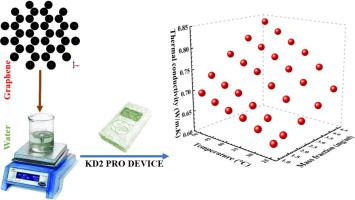当前位置:
X-MOL 学术
›
Int. Commun. Heat Mass Transf.
›
论文详情
Our official English website, www.x-mol.net, welcomes your
feedback! (Note: you will need to create a separate account there.)
Increase thermal conductivity of aqueous mixture by additives graphene nanoparticles in water via an experimental/numerical study: Synthesise, characterization, conductivity measurement, and neural network modeling
International Communications in Heat and Mass Transfer ( IF 6.4 ) Pub Date : 2020-11-01 , DOI: 10.1016/j.icheatmasstransfer.2020.104864 Jalal Alsarraf , Omid Malekahmadi , Arash Karimipour , Iskander Tlili , Aliakbar Karimipour , Majid Ghashang
International Communications in Heat and Mass Transfer ( IF 6.4 ) Pub Date : 2020-11-01 , DOI: 10.1016/j.icheatmasstransfer.2020.104864 Jalal Alsarraf , Omid Malekahmadi , Arash Karimipour , Iskander Tlili , Aliakbar Karimipour , Majid Ghashang

|
Abstract Graphene is a flexible and transparent conductor which can be used in varied material-apparatus applications, counting solar cells, phones, touch panels, and light-emitting diodes (LED). In the current experiment, Graphene preparation by Top-down method and stability of Graphene-Water nanofluid studied. Then, as the main aim, thermal conductivity (TC) of few-layered Graphene measured and numerically modeled. To analysis Microstructural observation and Phase study of nanoparticles, XRD, DLS, FTIR, FESEM-EDX, and TEM applied. Also, to read the stability of nanofluid, UV–Vis, Zeta-potential and DSC-TG applied. The range of Thermal conductivity test for mass fraction was 1.0–4.5 mg/ml, and for temperature was 25–50 °C. More than three months for nanofluid stability confirmed by stability tests. More ever, the thermal stability test for 1.0 mg/ml nanofluid confirmed its operational temperature range up to 1000 °C. Thermal conductivity enhancement (TCE) of 31.08%, measured at 4.5 mg/ml mass fraction at 50 °C temperature. To compute nanofluid's TC, the numerical study by new correlation (including 2.19% utmost deviation) and an Artificial neural network with R2 = 0.999 modeled. As a result, Graphene-Water nanofluid is stable, and in thermal systems, it has agreeable heat transfer potential.
中文翻译:

通过实验/数值研究,通过添加石墨烯纳米颗粒在水中提高水性混合物的热导率:合成、表征、电导率测量和神经网络建模
摘要 石墨烯是一种柔性透明导体,可用于各种材料设备应用、太阳能电池计数、电话、触摸面板和发光二极管 (LED)。在本实验中,研究了自顶向下法制备石墨烯和石墨烯-水纳米流体的稳定性。然后,作为主要目标,测量和数值模拟少层石墨烯的热导率 (TC)。为了分析纳米颗粒的微观结构观察和相研究,应用了 XRD、DLS、FTIR、FESEM-EDX 和 TEM。此外,为了读取纳米流体的稳定性,应用了 UV-Vis、Zeta 电位和 DSC-TG。质量分数的热导率测试范围为 1.0-4.5 mg/ml,温度为 25-50 °C。通过稳定性测试证实纳米流体稳定性超过三个月。更重要的是,热稳定性测试为 1。0 mg/ml 纳米流体证实其工作温度范围高达 1000 °C。热导率增强 (TCE) 为 31.08%,在 50 °C 温度下以 4.5 mg/ml 质量分数测量。为了计算纳米流体的 TC,通过新的相关性(包括 2.19% 最大偏差)和 R2 = 0.999 建模的人工神经网络进行数值研究。因此,石墨烯-水纳米流体是稳定的,在热系统中具有良好的传热潜力。
更新日期:2020-11-01
中文翻译:

通过实验/数值研究,通过添加石墨烯纳米颗粒在水中提高水性混合物的热导率:合成、表征、电导率测量和神经网络建模
摘要 石墨烯是一种柔性透明导体,可用于各种材料设备应用、太阳能电池计数、电话、触摸面板和发光二极管 (LED)。在本实验中,研究了自顶向下法制备石墨烯和石墨烯-水纳米流体的稳定性。然后,作为主要目标,测量和数值模拟少层石墨烯的热导率 (TC)。为了分析纳米颗粒的微观结构观察和相研究,应用了 XRD、DLS、FTIR、FESEM-EDX 和 TEM。此外,为了读取纳米流体的稳定性,应用了 UV-Vis、Zeta 电位和 DSC-TG。质量分数的热导率测试范围为 1.0-4.5 mg/ml,温度为 25-50 °C。通过稳定性测试证实纳米流体稳定性超过三个月。更重要的是,热稳定性测试为 1。0 mg/ml 纳米流体证实其工作温度范围高达 1000 °C。热导率增强 (TCE) 为 31.08%,在 50 °C 温度下以 4.5 mg/ml 质量分数测量。为了计算纳米流体的 TC,通过新的相关性(包括 2.19% 最大偏差)和 R2 = 0.999 建模的人工神经网络进行数值研究。因此,石墨烯-水纳米流体是稳定的,在热系统中具有良好的传热潜力。











































 京公网安备 11010802027423号
京公网安备 11010802027423号